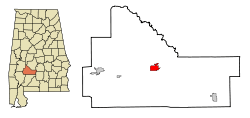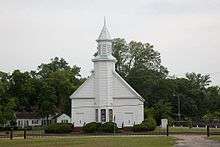Camden, Alabama
| Camden | |
|---|---|
| City | |
|
Wilcox County Courthouse in Camden, completed in 1857. | |
 Location in Wilcox County and the state of Alabama | |
| Coordinates: 31°59′56″N 87°17′45″W / 31.9988°N 87.2957°WCoordinates: 31°59′56″N 87°17′45″W / 31.9988°N 87.2957°W | |
| Country | United States |
| State | Alabama |
| County | Wilcox |
| Area | |
| • Total | 4.2 sq mi (11 km2) |
| • Land | 4.2 sq mi (11 km2) |
| • Water | 0 sq mi (0 km2) |
| Elevation | 207 ft (63 m) |
| Population (2010) | |
| • Total | 2,020 |
| • Density | 537.4/sq mi (205.2/km2) |
| Time zone | Central (CST) (UTC-6) |
| • Summer (DST) | CDT (UTC-5) |
| ZIP code | 36726 |
| Area code(s) | 334 |
| FIPS code | 01-11512 |
| GNIS feature ID | 0115426 |
Camden is a city[1] in Wilcox County, Alabama, United States.[2] The population was 2,020 at the 2010 census, down from 2,257 in 2000, at which time it was a town.
History
What is now Camden was established on property that was donated by Thomas Dunn in order to have a new town founded on the site. Dunn's Federal style house, built in 1825, is the oldest documented house in the town.[3] The first county seat was in the community of Canton Bend. It was moved to Barboursville, later renamed Camden, in 1833. It had been named Barboursville in honor of United States Congressman Philip Barbour of Virginia. Incorporated in 1841, Camden was renamed by local physician John D. Caldwell in honor of his hometown of Camden, South Carolina.[4]

The earliest documented industries in the town were a brickyard, sawmill, and window fabricator.[5] The Camden Phenix was the town's earliest known newspaper.[5] It also became the home of the red-brick Greek-Revival style Wilcox Female Seminary and Female Institute, built from 1845–50.[5] It has housed the Wilcox County Historical Society since 1976.[6] The red-brick Greek-Revival style Wilcox County Courthouse, also listed on the National Register, was completed in 1857. It replaced an earlier wood-frame structure.
During the American Civil War, many in the community joined the Confederate cause. The county courthouse was ransacked by Union forces in 1865, but advance warning allowed county officials to remove the county records to a safe place (legend claims that they were buried in a coffin) prior to their arrival.[5] Already devastated by the after effects of the Civil War, Camden suffered fires during 1869 and 1870 that destroyed about two-thirds of the town. The town finally began a slow recovery beginning during the 1880s, with the first bank incorporated in 1894.[5]
Camden benefited economically during the mid-20th century with the construction of a paper mill at Yellow Bluff and of the Millers Ferry Lock and Dam, a hydroelectric dam on the Alabama River near Millers Ferry that created the William "Bill" Dannelly Reservoir.[5]
Geography
Camden is located at 31°59′56″N 87°17′45″W / 31.99889°N 87.29583°W (31.998851, -87.295743).[7] According to the United States Census Bureau, the town had an area of 4.2 square miles (11 km2), of which 4.2 square miles (11 km2) is land and 0.24% is water.
Demographics
| Historical population | |||
|---|---|---|---|
| Census | Pop. | %± | |
| 1850 | 800 | — | |
| 1880 | 590 | — | |
| 1890 | 545 | −7.6% | |
| 1900 | 478 | −12.3% | |
| 1910 | 648 | 35.6% | |
| 1920 | 700 | 8.0% | |
| 1930 | 697 | −0.4% | |
| 1940 | 909 | 30.4% | |
| 1950 | 931 | 2.4% | |
| 1960 | 1,121 | 20.4% | |
| 1970 | 1,742 | 55.4% | |
| 1980 | 2,406 | 38.1% | |
| 1990 | 2,414 | 0.3% | |
| 2000 | 2,257 | −6.5% | |
| 2010 | 2,020 | −10.5% | |
| Est. 2015 | 1,930 | [8] | −4.5% |
| U.S. Decennial Census[9] 2013 Estimate[10] | |||
As of the census[11] of 2000, there were 2,257 people, 868 households, and 584 families residing in the town. The population density was 533.7 people per square mile (206.0/km2). There were 965 housing units at an average density of 228.2 per square mile (88.1/km2). The racial makeup of the town was 54.23% African American, 45.28% White, 0.09% Native American, 0.09% from other races, and 0.31% from two or more races. 0.53% of the population were Hispanic or Latino of any race.
There were 868 households out of which 35.9% had children under the age of 18 living with them, 37.6% were married couples living together, 27.0% had a female householder with no husband present, and 32.7% were non-families. 31.0% of all households were made up of individuals and 16.0% had someone living alone who was 65 years of age or older. The average household size was 2.45 and the average family size was 3.09.
In the town the population was spread out with 29.1% under the age of 18, 8.6% from 18 to 24, 24.2% from 25 to 44, 19.8% from 45 to 64, and 18.3% who were 65 years of age or older. The median age was 36 years. For every 100 females there were 78.3 males. For every 100 females age 18 and over, there were 71.2 males.
The median income for a household in the town was $25,750, and the median income for a family was $28,854. Males had a median income of $35,625 versus $20,735 for females. The per capita income for the town was $14,272. About 31.4% of families and 33.6% of the population were below the poverty line, including 43.3% of those under age 18 and 29.6% of those age 65 or over.
2010 census
As of the census[12] of 2010, there were 2,020 people, 790 households, and 540 families residing in the town. The population density was 481.0 people per square mile (183.6/km2). There were 927 housing units at an average density of 220.7 per square mile (84.3/km2). The racial makeup of the town was 57.4% African American, 42.0% White, 0.1% Native American, 0.1% from other races, and 0.4% from two or more races. 0.7% of the population were Hispanic or Latino of any race.
There were 790 households out of which 31.0% had children under the age of 18 living with them, 36.1% were married couples living together, 26.3% had a female householder with no husband present, and 31.6% were non-families. 29.9% of all households were made up of individuals and 14.4% had someone living alone who was 65 years of age or older. The average household size was 2.47 and the average family size was 3.07.
In the town the population was spread out with 28.6% under the age of 18, 7.1% from 18 to 24, 21.0% from 25 to 44, 25.9% from 45 to 64, and 17.4% who were 65 years of age or older. The median age was 37.7 years. For every 100 females there were 78.6 males. For every 100 females age 18 and over, there were 80.3 males.
The median income for a household in the town was $21,563, and the median income for a family was $37,031. Males had a median income of $60,250 versus $23,380 for females. The per capita income for the town was $15,978. About 27.0% of families and 31.6% of the population were below the poverty line, including 42.6% of those under age 18 and 15.6% of those age 65 or over.
Education
- Wilcox Academy, a private K-12 academy
- Wilcox Central High School, a public high school
Notable people
- Henry Aaron right fielder, born here, but raised in Mobile.
- Daniel Albritton, former head of the National Oceanic and Atmospheric Administration's Aeronomy Laboratory
- Johnny Baker - former American Football League linebacker and tight end.
- Jo Bonner - former U.S. Representative
- A. B. George (1829-1899), Wilcox County native, native, mayor of Minden, Louisiana, 1856 to 1858, state senator, district attorney, and upon relocation to Shreveport, a judge of the appeals court[13]
- Hank Harris, former guard for the Washington Redskins.
- Kay Ivey - Alabama State Treasurer, Lieutenant Governor
- Tom Jenkins - reserve outfielder.
- Elliott Jones, first head football coach for of Vanderbilt University.
- Annie L. Key, former member of the Ohio Representative.
- Ronnie McNeir - singer-songwriter.
- Benjamin Meek Miller - Alabama Governor.
- Jimmy Newberry, pitcher in the Negro Leagues and the Pacific League.
- J. De Forest Richards, former American football player and banker.
- Jeff Sessions- U.S. Attorney, Alabama Attorney General, U.S. Senator.
- Palmer Williams Jr., actor.
Transportation
Intercity bus service is provided by Greyhound Lines.[14]
References
- ↑ U.S. Census change list Archived August 6, 2010, at the Wayback Machine.
- ↑ "Find a County". National Association of Counties. Archived from the original on 2011-05-31. Retrieved 2011-06-07.
- ↑ "Dunn-Fairley-Bonner-Field House at Camden, AL (built c. 1825)". Rural Southwest Alabama. Retrieved May 6, 2014.
- ↑ "Camden". The Encyclopedia of Alabama. Retrieved May 6, 2014.
- 1 2 3 4 5 6 "Wilcox County". The Encyclopedia of Alabama. Retrieved May 6, 2014.
- ↑ "Wilcox Female Institute". Encyclopedia of Alabama. Retrieved May 6, 2014.
- ↑ "US Gazetteer files: 2010, 2000, and 1990". United States Census Bureau. 2011-02-12. Retrieved 2011-04-23.
- ↑ "Annual Estimates of the Resident Population for Incorporated Places: April 1, 2010 to July 1, 2015". Retrieved July 2, 2016.
- ↑ "U.S. Decennial Census". Census.gov. Archived from the original on May 11, 2015. Retrieved June 6, 2013.
- ↑ "Annual Estimates of the Resident Population: April 1, 2010 to July 1, 2013". Retrieved June 3, 2014.
- ↑ "American FactFinder". United States Census Bureau. Archived from the original on 2013-09-11. Retrieved 2008-01-31.
- ↑ "American FactFinder". United States Census Bureau. Archived from the original on 2013-09-11. Retrieved 2015-08-18.
- ↑ John A. Agan (Webster Parish official historian). "The Impact of the Minden Male Academy". Minden Press-Herald in mindenmemories.org. Retrieved March 24, 2015.
- ↑ Camden, AL Greyhound Station Intercity bus service

